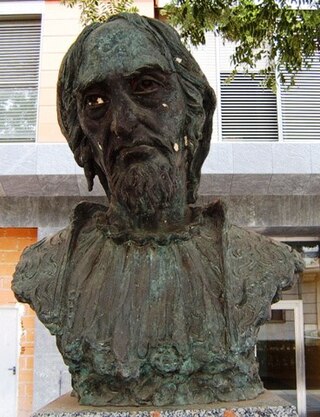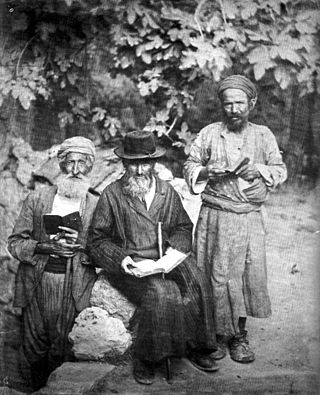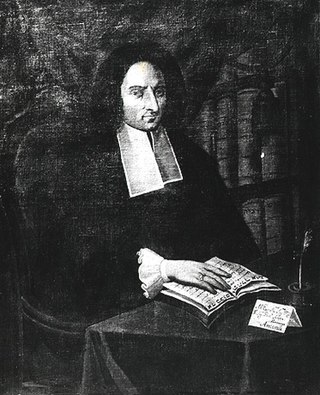Related Research Articles

Moses de León, known in Hebrew as Moshe ben Shem-Tov, was a Spanish rabbi and Kabbalist who first publicized the Zohar. Modern scholars believe the Zohar is his own work, despite his claim that he took traditions going back to Shimon bar Yochai and committed them to writing. His other works include Sefer ha-Rimon, written in Hebrew, and hundreds of pseudepigraphic responsa, commentaries, and Kabbalistic tracts which he falsely attributed to earlier authorities.
Rabbi Isaac Tyrnau was an Austrian rabbi, born in the late 14th century and active in the 15th century; he is most famous for his Sefer haMinhagim.

Josippon is a chronicle of Jewish history from Adam to the age of Titus. It is named after its supposed author, Flavius Josephus, though it was actually composed in the 10th century in Southern Italy. The Ethiopic version of Josippon is recognized as canonical by the Ethiopian Orthodox Tewahedo Church and the Eritrean Orthodox Tewahedo Church.

Levi ibn Habib, also known by the acronym HaRaLBaCh, was Chief Rabbi of Jerusalem from 1525 until his death.
Azariah ben Moses dei Rossi was an Italian physician, Jewish rabbi, and scholar. He was born at Mantua in c. 1511; and died in 1578. He was descended from an old Jewish family which, according to tradition, was brought by Titus from Jerusalem. He was known among Jews as Azariah min-Ha'adumim, a play on his name as well as a possible allusion to the fact that he lived in Catholic Italy, Rome being regarded as a spiritual heir of Esau. Combining an insatiable desire for learning with remarkable mental power, Dei Rossi early in life became exceptionally proficient in Hebrew, Latin, and Italian literature. He became known for his critical thinking and erudition. He studied simultaneously medicine, archeology, history, Greek and Roman antiquities, and Christian ecclesiastical history. When about the age of thirty he married and settled for a time at Ferrara. Later he was found at Ancona, Bologna, Sabbionetta, and again at Ferrara. In 1570 a terrible earthquake visited the last-named city and caused the death of about 200 persons. The house in which Dei Rossi lived was partly destroyed; but it happened that at the moment he and his wife were in their daughter's room, which remained uninjured. During the disturbances consequent upon the earthquake Dei Rossi lived in an outlying village, where he was thrown into association with a Christian scholar, who asked him if there existed a Hebrew translation of the Letter of Aristeas. Dei Rossi answered in the negative, but in twenty days he prepared the desired translation, which he entitled Hadrat Zekenim. His account of the earthquake, written shortly after, is entitled Kol Elohim; he regarded the earthquake as a visitation of God, and not merely as a natural phenomenon.
Shem Tov ben Abraham ibn Gaon was a Spanish Talmudist and kabbalist.
Simeon ben Zemah Duran, also Tzemach Duran, known as Rashbatz (רשב"ץ) or Tashbatz was a Rabbinical authority, student of philosophy, astronomy, mathematics, and especially of medicine, which he practised for a number of years at Palma de Mallorca. A major 15th century posek, his published decisions in matters of halakha have been widely quoted in halakhic literature for hundreds of years.
Samuel ben Hayyim Vital was a Kabalist born in Damascus in the latter half of the sixteenth century. While still young he married a daughter of Isaiah Pinto, rabbi of Damascus. Poverty compelled him to emigrate to Egypt, where, through the influence of prominent men, he was placed in charge of the cabalistic society Tiḳḳune ha-Teshubah. After a brief residence there he went to Safed, where he instructed the physician Jacob Zemah in Kabala. In the middle of the 17th century he returned to Egypt, where he died.
Moses ben Mordecai Zacuto, also known by the Hebrew acronym RaMa"Z, was a rabbi, Kabbalist, and poet. Zacuto, who was born into a Portuguese Marrano family in Amsterdam, studied Jewish subjects under Saul Levi Morteira. He also studied secular subjects, such as the Latin language. As a pupil of Morteira, he may also have been, as a youth still in Amsterdam, a fellow student of Baruch Spinoza.
Jedidiah Solomon ben Abraham Norzi (1560–1626) was a Rabbi and exegete, best known for his work Minchat Shai.
Felix Pratensis was a Sephardic Jewish scholar who embraced Roman Catholicism. He is known for his collaboration with the Flemish printer Daniel Bomberg on the first printed Hebrew Biblia Rabbinica (Veneta) of 1517/8.
Abraham Yagel was an Italian Jewish catechist, philosopher, and cabalist. He lived successively at Luzzara, Venice, Ferrara, and Sassuolo.
Judah ben Isaac Cardinal was a translator who lived at the end of the twelfth century and the beginning of the thirteenth, probably in Southern France.

Samson Morpurgo ben Joshua Moses was an Italian rabbi, physician, and liturgist.
Jacob ben Hayyim ben Isaac ibn Adonijah or Jacob ben Chayyim, was a scholar of the Masoretic textual notes on the Hebrew Bible, exegete and printer. Born in Tunis, he left his native country to escape the persecutions that broke out there at the beginning of the sixteenth century. After residing at Rome and Florence he settled at Venice, where he was engaged as corrector of the Hebrew press of Daniel Bomberg. Later in life he converted to Christianity. Jacob's name is known chiefly in connection with his edition of the Rabbinical Bible (1524–25), which he supplied with Masoretic notes and an introduction which discusses the Masorah, qere and ketib, and the discrepancies between the Talmudists and the Masorah. The value of his activity as a Masorite was recognized even by Elijah Levita, who, however, often finds fault with his selections.
Jewish printers were quick to take advantages of the printing press in publishing the Hebrew Bible. While for synagogue services written scrolls were used, the printing press was very soon called into service to provide copies of the Hebrew Bible for private use. All the editions published before the Complutensian Polyglot were edited by Jews; but afterwards, and because of the increased interest excited in the Bible by the Reformation, the work was taken up by Christian scholars and printers; and the editions published by Jews after this time were largely influenced by these Christian publications. It is not possible in the present article to enumerate all the editions, whole or partial, of the Hebrew text. This account is devoted mainly to the incunabula.
The Hebrew incunabula are a group of Jewish religious texts printed in Hebrew in the 15th century.
Estellina Conat was an Italian-Jewish printer. She was the first woman active as a printer.
Hayyim ben David Schwartz was an early Hebrew printer, typographer, and editor, known as the first Jewish printer of Hebrew books in Germany.
Abraham ben Moses Schedel was a Bohemian printer and corrector.
References
- Giovanni Bernardo De Rossi, Annals, pp. 8–11, 110–114, 177;
- Zunz, Z. G. pp. 249, 250;
- Moritz Steinschneider, Cat. Bodl. col. 2866, No. 7957;
- Steinschneider and Cassel, Jüdische Typographie, in Ersch and Gruber, Encyc. section ii., part 28, p. 34;
- Wolf, Bibl. Hebr. i. 67, No. 102;
- Julius Fürst, Bibl. Jud. i. 185;
- D. Chwolson, in Sbornik, St. Petersburg, 1896, pp. 3, 6, 7;
- Chwolson Jubilee Volume, p. 68.